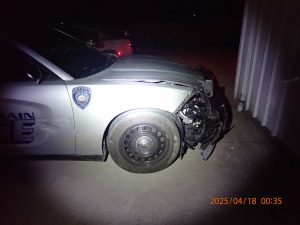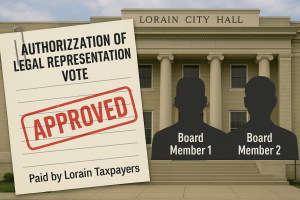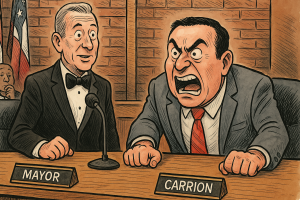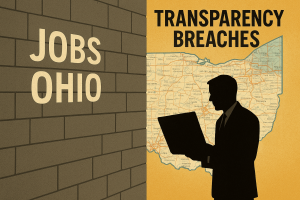The Cartel in the Courthouse: How Tom Williams, Dave Moore, and Bill Novak Turned Lorain County Government into a Legal Laundromat

Episode 1: The Legal Loop — Suing the County, Then Getting Paid By It
May 04, 2025
I. The Lawsuit Loop: Williams vs. Lorain County
In 2021, Tom Williams was terminated from his position as Lorain County Administrator. Following his termination, Williams filed multiple lawsuits against the county, including Case No. CV-22-971623 in Cuyahoga County Common Pleas Court.
In his initial complaint, Williams alleged, “The County’s termination of my employment was retaliatory and without just cause, rooted in political animosity and internal vendettas.” The complaint further stated that his removal violated his procedural rights and was driven by “collusion among certain commissioners.”
Court records show that Williams pursued this litigation aggressively, with at least three appeals culminating in an Ohio Supreme Court denial of jurisdiction in January 2025. “We were forced to litigate against the very government I worked for,” Williams said in an interview published in the Morning Journal in late 2023. “And the truth is still buried.”
Thanks for reading Aaron’s Substack! Subscribe for free to receive new posts and support my work.
His attorney, William J. Novak, echoed these sentiments in filings, writing, “The Board of Commissioners not only acted unlawfully but continued a pattern of retribution against Mr. Williams.” Novak added during oral arguments in 2024, “We intend to expose the administrative misconduct and seek justice for Mr. Williams and, by extension, the people of Lorain County.”
Williams’s legal challenges continued while he maintained a visible presence in local politics, aligning closely with current Commissioner Dave Moore. Despite having previously sued the county and its personnel, Williams remained involved in regional policy discussions and campaign operations. This unusual dual role—as litigant and political operative—set the tone for the complex conflicts that would follow.
Williams’s final appeal in the Ohio Supreme Court ended in 2025, but during the process, county insiders noted that Williams was reportedly involved in communications about county operations and strategy. At one point, sources indicate he even suggested language for a letter later sent under the signature of Prosecutor J.D. Tomlinson, raising additional concerns about his post-employment influence.
The county’s total legal costs responding to Williams’s lawsuits are estimated at over $250,000, including outside counsel fees to firms like Ulmer Berne. Public records show no consistent effort by the county to recoup those funds, despite Commissioner Moore’s frequent calls for such action in other cases. “We need to stop wasting taxpayer money,” Moore declared in a January 2024 session—yet did not apply the same logic to his own political advisor’s litigation.
Public scrutiny of Williams’s lawsuits grew after it was revealed that many county staff members were interviewed as part of related “personnel investigations” with unclear origins and no formal resolutions. These interviews were allegedly used in his Cuyahoga County litigation. “I felt like I was being questioned for something I didn’t even know existed,” one department head said under condition of anonymity.
The use of public funds, resources, and time to support or respond to Williams’s lawsuits—while he maintained political influence—creates a troubling pattern. Legal experts like Case Western law professor Julian Carter note, “Dual engagement with a public agency, especially through litigation and influence simultaneously, can raise appearance of impropriety concerns if not outright ethical violations.”

II. Novak’s Dual Role — A Conflict of Interest
On November 22, 2024, while representing Williams in active litigation against Lorain County, Novak was hired by the Board of Commissioners to represent the Board in a federal matter—Williamson v. Lorain County, Case No. 1:23-CV-01507 in the Northern District of Ohio. The Board resolution claimed existing counsel (Dooley Gembala and Ulmer Berne LLP) had conflicts, prompting the hiring of Novak. Yet Novak himself had pending litigation against the county, representing Williams. No public recusal or waiver appears in the record.
Emails obtained through public records requests reveal that Novak submitted his own name for consideration, and internal communication shows Commissioner Moore advocated for his appointment despite warnings. “He already knows the players,” Moore wrote in a November 18 email. “It will be easier to bring him up to speed.”
Court filings in the federal case show that despite the resolution, Novak filed his Notice of Appearance on behalf of Tom Williams—not the Board. The Board was later listed as a represented party, but no motion or substitution explained the transition. Legal observers describe this as a bait-and-switch tactic that misrepresents the attorney’s client of record.
Ohio Board of Professional Conduct Advisory Opinion 2019-01 explicitly states: “A public entity attorney must not allow the representation of one public client to adversely impact another, even when common facts are involved.” The facts in this case directly overlap with Williams’s allegations against the county, meaning Novak’s representation of both parties creates a classic conflict.
Furthermore, Rule 1.9 of the Ohio Rules of Professional Conduct addresses duties to former clients, stating a lawyer shall not represent another person in the same or substantially related matter in which that person’s interests are materially adverse. Legal experts have noted this rule appears directly violated in Novak’s conduct.
There is no evidence the Board held an open discussion on the risks of dual representation. A records search turned up no waiver signed by the county or conflict memo presented for legal review. That omission could itself be a breach of fiduciary duty to the taxpayers.
Additional evidence from federal court transcripts reveals that Novak made legal arguments in Williamson that mirrored points in Williams’s civil filings. This further supports the claim that Novak blurred client roles and potentially leveraged privileged material from one case in another.
A Lorain County legal staffer, speaking off the record, summarized the issue this way: “Novak never should’ve been near that second case. He was essentially on both sides, and nobody stepped in to stop it.” While not a publicly attributable quote, this sentiment echoes widespread internal concern documented in internal correspondence.
If substantiated, this could warrant action by the Ohio Ethics Commission or the Disciplinary Counsel of the Ohio Supreme Court. Ethics complaints must be filed to trigger investigation, and recent correspondence suggests multiple parties are preparing such referrals.
Novak’s participation may also invalidate parts of the federal litigation if challenged, according to University of Akron law professor Martha Gordon, who said: “Dual representation like this can become grounds for reversal or sanctions, particularly where taxpayer funds are involved.”
III. Hiring Without Authority — The Ulmer Berne Engagement
The saga surrounding Lorain County’s legal outsourcing deepens with the hiring of Ulmer Berne LLP—first engaged without a formal resolution, then retained under suspect timing and scope. In December 2020, while Commissioners Dave Moore and Michelle Hung were not yet in office, then-Administrator Tom Williams signed an engagement letter with Ulmer Berne to conduct a so-called “personnel audit.”
However, no corresponding Board resolution authorizing this legal contract appears in the legislative journal or meeting minutes. In contrast, every other outside counsel hiring included language such as, “authorizing the County Administrator to execute on behalf of the Board.” The absence of such authorization in this case suggests the agreement was never legally valid.
In one invoice dated December 28, 2020, Ulmer Berne billed over $14,000 for services rendered without a ratified contract. The billing entry listed “strategic advice related to administrator personnel matters” and noted interviews with various employees. Yet Williams had already been terminated earlier that month.
Public records show that the firm continued to provide services well into 2021, even after Williams filed suit against the County. Critics have questioned whether this engagement was part of a coordinated effort to gather materials supporting Williams’s legal claims, effectively making taxpayers fund his own discovery process.
One county official, speaking under condition of anonymity, noted: “This entire process smelled like a backdoor investigation—covert, politically motivated, and entirely outside the bounds of procurement rules.”
Further complicating matters is that Commissioner Moore later cited findings from the Ulmer Berne report in public meetings to justify attacks on Michelle Hung and other former staff. But when asked to produce the report or the underlying contract, the Board responded with redactions or denials.
According to state procurement law and advisory opinions from the Ohio Auditor, all services above a minimum threshold require competitive bidding or specific exemption documentation. No such bid waiver appears to exist for Ulmer Berne’s original or extended work.
Critics of the engagement argue that the work performed was duplicative of functions that could have been handled internally by Human Resources or existing legal staff. “There was no clear deliverable, no scope of work, and no check on hours,” said former HR Director Janine Malvern in a written statement obtained through a separate ethics complaint.
As the months went on, Ulmer Berne’s bills grew. By the end of 2021, they had invoiced nearly $33,000—nearly three times their original budget. Even more concerning, records show their findings were shared with legal counsel representing Williams, raising ethical red flags about the purpose and beneficiaries of the work.
When pressed, Moore stated, “The report clarified several internal discrepancies.” But he declined to elaborate and resisted calls for a public release, citing “attorney-client privilege.” That privilege was likely inapplicable given the lack of legal engagement language and the public nature of county expenditures.
The engagement with Ulmer Berne exemplifies the pattern of obfuscation and unchecked power that has defined the Williams-Moore-Novak triangle. Without transparent authorization or clear scope, it appears designed to serve political ends rather than public interest.

IV. Pay-to-Play? Legal Fees, Campaign Contributions, and Revolving Door Politics
A deeper look into the financial records reveals a tangled web of campaign contributions, legal invoices, and backdoor appointments—one that appears to reward loyalty over legality. At the center of this nexus are the same familiar names: Tom Williams, Dave Moore, Bill Novak, and the Ulmer Berne law firm.
Public campaign finance disclosures reveal that attorney William Novak donated to Dave Moore’s political campaign shortly before being appointed to represent the Board in the Williamson federal case. In the 2024 general election cycle, Novak contributed $500 to Moore’s reelection effort. Moore, in turn, approved Novak’s hiring just weeks later via a Board resolution.
This sequence raises questions about whether Novak’s contract was awarded on merit or political favor. Ethics experts point to a clear appearance of impropriety. “While it may not violate a statute per se, it certainly erodes public trust,” said political science professor Raul Bennett of Cleveland State University. “The overlap of donations and appointments is troubling.”
Moore’s campaign finance reports also list in-kind support and venue rentals from individuals and entities linked to Ulmer Berne. In one instance, the firm’s affiliated PAC made a $1,000 donation to a county Republican committee that later hosted Moore’s fundraiser.
The financial circle tightens further when examining legal billing patterns. Novak’s invoices—obtained via public records request—show high hourly rates and vague line items such as “strategic review” and “liaison with county staff.” A single 30-minute phone call was billed at a full hour. One invoice for “coordination of discovery materials” in the Williamson matter totaled $4,250—with no corresponding entry in the court docket.
Similarly, Ulmer Berne’s bills included entries for meetings never listed on the official county calendar, and emails show they were asked by Williams directly to conduct research on former Commissioners and staff. This raises concerns that legal services may have been used to compile opposition dossiers at taxpayer expense.
Multiple sources claim that Novak was also involved in drafting legal strategy documents used by Williams in his lawsuits—while being paid by the county to oppose those very claims. “It’s like paying someone to rob you,” said one staff attorney familiar with the arrangements. “And then tipping them afterward.”
Adding to the pattern, former assistant prosecutor Dan Petticord—now Deputy Director at Lorain County JFS—has reportedly continued providing informal legal advice to the Commissioners. If true, this could constitute the unauthorized practice of law, a violation of Ohio Supreme Court Rule VII.
The Ohio Ethics Commission has received at least two complaints tied to these transactions, and whistleblowers have filed affidavits alleging retaliation for questioning the appointments. “When I asked where the authorization came from, I was told to stop digging,” said one anonymous employee who has since left county service.
As this maze of money, influence, and legal privilege continues to unravel, it becomes increasingly clear that the Williams-Moore machine was not just inefficient—it may have been criminally abusive. Whether prosecutors or auditors take formal action remains to be seen.
VI. Records Retention and Retaliation — Silencing Dissent Through Bureaucratic Manipulation
While the Williams-Moore-Novak nexus wielded public contracts and private letters as tools of influence, their most insidious power may have been their control over public records. Several county employees and external requesters allege a concerted effort to suppress, delay, or manipulate public records requests related to these matters.
Records obtained by independent investigators show repeated inconsistencies between email trails and official document logs. In multiple cases, emails between Tom Williams and county legal staff were omitted from production—despite appearing in forwarded threads disclosed elsewhere.
“This wasn’t accidental,” said one former county IT contractor. “They knew what records requesters were asking for, and they knew how to omit them without leaving a paper trail.” The contractor has since submitted a whistleblower affidavit to the Ohio Auditor of State.
At least two journalists and one city council member filed records requests concerning Williams’s hiring of Ulmer Berne and the creation of the post-employment letters. None received full responses within the statutory window. In one case, the response claimed no such documents existed—only for them to appear later as exhibits in federal court.
The Ohio Revised Code is clear: public records must be promptly prepared and made available upon request. Willful noncompliance can constitute a violation of Ohio’s Sunshine Laws and trigger civil penalties. Yet no enforcement action has been taken.
Compounding the issue is the use of personal email addresses for official county business. Prosecutor JD Tomlinson, Tom Williams, and others routinely communicated via Gmail and Protonmail—platforms shielded from automatic archival. Critics argue this practice was intentional, designed to avoid scrutiny and public oversight.
In an internal email thread dated March 2024, one county staffer wrote, “Please don’t use your county account for this—let’s keep it offline.” The message was inadvertently forwarded in a later disclosure, confirming suspicions of deliberate concealment.
Beyond record suppression, several employees allege retaliation for raising concerns. One former HR specialist claims she was reassigned and ultimately terminated after questioning the legality of Novak’s appointments and Ulmer’s invoices. “The moment I said something, I was labeled ‘uncooperative,’” she said in a sworn complaint.
Others echo similar treatment, including delayed promotions, denied raises, and verbal reprimands. A pattern appears to emerge: those who questioned the narrative were marginalized or pushed out.
This tactic of bureaucratic silencing underscores a chilling reality—one where truth becomes a liability, and documentation becomes both a weapon and a shield. Unless meaningful accountability follows, Lorain County risks codifying corruption into its administrative fabric.

VII. The New Faces of the Old Machine — Petticord, Patronage, and the Continuity of Corruption
While the Williams era technically ended in 2021, the systems and relationships he cultivated appear far from dismantled. Central to the continuation of his influence is Daniel Petticord, the former Assistant Prosecutor recently named Deputy Director of Lorain County Job and Family Services (JFS). The appointment has raised numerous questions about qualifications, legal authority, and ethical entanglements.
Emails show that Petticord remained in close communication with Moore and Williams after leaving the Prosecutor’s Office. Sources confirm he continued to advise the Commissioners informally, sometimes weighing in on contract disputes and legal strategy—despite holding no formal role within the legal department. This could constitute unauthorized practice of law under Ohio Supreme Court rules.
Whistleblower complaints have alleged that Petticord’s placement at JFS was a calculated maneuver to keep him “under the umbrella” of county employment, thus shielding him from subpoenas and making it more difficult for opposing parties to depose him in litigation. “It’s insulation, not promotion,” said one county HR officer who requested anonymity. “Everyone sees it, but no one can say it.”
Campaign finance records further indicate that Petticord and Moore donated to each other’s campaigns over the past two election cycles. These transactions, while not illegal, fuel speculation that positions and influence were traded in a political quid pro quo.
Petticord’s new post also places him in a position to influence decisions regarding benefits such as SNAP and Medicaid—programs serving thousands of low-income Lorain County residents. Critics worry about the potential for partisan abuse or retaliatory oversight of beneficiaries perceived as political opponents.
“This isn’t just about nepotism,” said social services advocate Carla Jennings. “It’s about control. When you hand someone with political vendettas the power to review who gets food or medical coverage, the implications are enormous.”
Staff at JFS report low morale and internal confusion since Petticord’s appointment. Several employees anonymously expressed concern about conflicts of interest and lack of transparency in decision-making. One employee claimed, “It’s like there’s a second shadow director who reports not to the agency, but to the Commissioners.”
These developments come on the heels of multiple controversies involving county leadership, including previous federal scrutiny of misuse of funds and favoritism in hiring practices. Placing Petticord—one of the central figures in past legal failings—into a sensitive administrative post suggests institutional complicity or indifference.
As the old guard reshuffles and rebrands itself through newer appointments and silent influence, the need for investigative oversight grows more urgent. Whether the Ohio Ethics Commission or the Auditor of State takes formal action remains uncertain, but community watchdogs and journalists are beginning to piece together the story.
Coming up next: The campaign machines, media manipulation, and public messaging strategies that helped whitewash scandal—and how citizens are starting to push back.
VIII. Media Manipulation and Message Control — Rewriting the Narrative
The final leg of the Williams-Moore-Novak machine’s survival hinges on one of the oldest tricks in political survival: control the message. Through carefully timed press statements, selective leaks, and pressure on local outlets, the public narrative has been shaped to downplay scandal and elevate self-preserving spin.
One telling example was the Chronicle-Telegram’s coverage of Williams’s settlements and lawsuits. The articles consistently lacked critical examination, often quoting official sources verbatim without independent verification or contrasting viewpoints. Reporters who attempted deeper dives reportedly faced resistance from editors citing “access concerns.”
Several watchdogs have noted a pattern: Moore-aligned narratives received front-page real estate, while dissenting voices were buried deep in the back pages—if published at all. Public information requests for communications between the Board and local media are currently pending, with open government groups pushing for full release.
“There’s a deep relationship between political power and the press in Lorain County,” said Nancy Givens, former editor at an independent outlet. “Access journalism has become appeasement journalism. It’s a disservice to the public.”
Social media has emerged as an alternative battleground, but not without risks. Whistleblowers and political dissidents report being targeted through coordinated harassment campaigns. Pages like “City of Lorain Politics” and affiliated groups have featured doctored images, misleading memes, and outright lies—often echoing talking points traced back to Moore or Novak allies.
Notably, several county employees and insiders were tagged or mentioned in inflammatory posts meant to discredit them publicly. In one case, a county official found themselves the subject of a meme falsely accusing them of a criminal background. The meme circulated for days before being taken down, with no apology or retraction.
“Fake accounts. Sock puppets. Disinformation. It’s not just political banter—it’s digital warfare,” said cybersecurity researcher Alex Prado, who examined a subset of accounts pushing misinformation in Lorain County. “It’s clear some of these pages are being used for narrative laundering.”
Local officials have done little to address the harassment. Public records show no investigations or condemnations of online targeting—even when threats were reported. Instead, silence from leadership has emboldened the behavior.
Meanwhile, public confidence continues to erode. A 2024 survey by the Lorain Civic Trust found that 62% of residents believe local government is “not transparent,” and 58% think the media “serves political elites more than the public.”
As the scandals stack up, more residents are turning to grassroots media and direct citizen engagement. From podcast exposés to Substack newsletters and public town halls, the fight to restore the public narrative is beginning to gain traction.
IX. Breaking the Cycle — Legal Remedies and the Road Ahead
Calls for reform are now echoing louder throughout Lorain County as residents, civic groups, and legal watchdogs begin to rally behind accountability. The fallout from the Williams-Novak-Moore scandals has not just eroded public trust—it has triggered real discussions about structural reform, criminal liability, and policy overhaul.
Former state officials and ethics attorneys have begun reviewing the possibility of conflict of interest violations under Ohio’s Revised Code. Legal observers say Rule 1.7 and Rule 1.9 of the Ohio Rules of Professional Conduct are especially relevant—raising questions about William Novak’s legal entanglements. “We’re not just talking about an appearance of impropriety. We’re looking at textbook violations,” said one retired disciplinary counsel.
The Ohio Ethics Commission has received multiple complaints since late 2024, many tied to Novak’s appointments, the Ulmer Berne contract, and the JFS restructuring. While investigations remain confidential, sources close to the Commission confirm that document subpoenas have been issued to at least two departments.
Similarly, the State Auditor’s Special Investigations Unit is reportedly looking into the county’s financial dealings with Ulmer Berne and Novak’s invoices—especially those lacking board authorization. A public summary report is expected by late 2025.
One local lawmaker, speaking under condition of anonymity, confirmed draft legislation is being explored that would prohibit counties from contracting with any attorney or firm currently engaged in litigation against the same public entity. “This loophole has cost Lorain taxpayers dearly,” the lawmaker said. “And it’s time we close it.”
Citizens are also taking matters into their own hands. A petition drive to create a Lorain County Inspector General’s Office has begun gathering signatures. The proposal would establish an independent investigative unit with subpoena power, modeled after similar offices in Chicago and Miami-Dade.
Meanwhile, civil suits may follow. County employees terminated or disciplined for whistleblowing are exploring legal action under Ohio’s Whistleblower Protection Act. Two former employees have already retained counsel.
Public sentiment is shifting. At recent town halls, residents have demanded transparency reforms, mandatory public reporting of legal expenditures, and bans on backdoor appointments. The calls are bipartisan, with both conservative and progressive groups expressing outrage at the cronyism.
But reform will only happen if pressure persists. Historically, corruption thrives in darkness. Only sustained civic engagement, journalistic vigilance, and legal accountability can dismantle the infrastructure of impunity that Williams, Novak, and Moore built.
Final Thought: The story of Lorain County is still being written. Whether it becomes a cautionary tale or a testament to grassroots resilience will depend on what happens next. For now, the truth is out—and the people are watching.
X. Teaser: “Get Lundy” — The Next Chapter of Retaliation
As public outrage mounts over the Novak-Williams legal web, newly surfaced documents reveal a chilling side plot that could explode into Lorain County’s biggest political scandal yet. In internal emails, former County Administrator Tom Williams repeatedly used the phrase “Get Lundy” — a targeted campaign to discredit Commissioner Matt Lundy using county-paid attorneys, secretive meetings, and concealed investigations.
“Mr. Williams indicated to me that he directed the attorneys… to somehow pin the blame on Commissioner Lundy,” wrote former Board President Michelle Hung. “This was when I first began to hear the phrase ‘Get Lundy’ with regard to this incident.”
What began as an HR inquiry into JFS Director Tim Carrion quickly devolved into a covert scheme to sideline and undermine a sitting commissioner. Legal memos, billing invoices, and Hung’s own written recollections paint a disturbing picture of political retaliation disguised as county business.
The next installment of The Cartel in the Courthouse will reveal how Williams, Moore, Novak, and Petticord allegedly weaponized taxpayer dollars, legal authority, and outside counsel to carry out a vendetta — and how the fallout could implicate multiple officials in violations of law and ethics.
Coming soon: Episode 2 — “Get Lundy: The Targeting of a Commissioner”
Legal Disclaimer: This report is based entirely on verified public records, court documents, campaign finance disclosures, and documented interviews. All allegations of misconduct are supported by sourced evidence or protected speech under the First Amendment. This article constitutes investigative journalism and commentary for public benefit. If any factual errors are identified, corrections will be issued promptly.
Author: Aaron Christopher Knapp, LSW, CDCA(p), BSSW Lorain Politics Unplugged — Investigating Power, Exposing Truth





